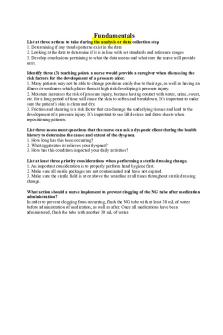Fundamentals Post Assignment PDF

| Title | Fundamentals Post Assignment |
|---|---|
| Course | Professional Career Development Seminar |
| Institution | Florida Agricultural and Mechanical University |
| Pages | 1 |
| File Size | 60.7 KB |
| File Type | |
| Total Downloads | 90 |
| Total Views | 128 |
Summary
Download Fundamentals Post Assignment PDF
Description
Fundamentals List at three actions to take during the analysis or data collection step 1. Determining if any trends/patterns exist in the data 2. Looking at the data to determine if it is in line with set standards and reference ranges 3. Develop conclusions pertaining to what the data means and what care the nurse will provide next. Identify three (3) teaching points a nurse would provide a caregiver when discussing the risk factors for the development of a pressure ulcer. 1. Many patients may not be able to change positions easily due to their age, as well as having an illness or weakness which places them at high risk developing a pressure injury. 2. Moisture increases the risk of pressure injury, because having contact with water, urine, sweat, etc. for a long period of time will cause the skin to soften and breakdown. It’s important to make sure the patient’s skin is clean and dry. 3. Friction and shearing is a risk factor that can damage the underlying tissues and lead to the development of a pressure injury. It’s important to use lift devices and draw sheets when repositioning patients. List three assessment questions that the nurse can ask a dyspneic client during the health history to determine the cause and extent of the dyspnea. 1. How long has this been occurring? 2. What aggravates or relieves your dyspnea? 3. How has this condition impacted your daily activities? List at least three priority considerations when performing a sterile dressing change. 1. An important consideration is to properly perform hand hygiene first. 2. Make sure all sterile packages are not contaminated and have not expired. 3. Make sure the sterile field is at or above the waistline at all times throughout sterile dressing change. What action should a nurse implement to prevent clogging of the NG tube after medication administration? In order to prevent clogging from occurring, flush the NG tube with at least 30 mL of water before administration of medication, as well as after. Once all medications have been administered, flush the tube with another 30 mL of water....
Similar Free PDFs

Fundamentals Post Assignment
- 1 Pages

Med Surg Post Assignment
- 2 Pages

Mental Health Post Assignment
- 2 Pages

Maternal Newborn Post Assignment
- 2 Pages

Pharmacology Post Assignment
- 2 Pages

Post Lab Assignment B
- 6 Pages

Lab 5 Post-Lab Assignment
- 3 Pages

Post - Lecture Assignment 2:27
- 2 Pages
![[LR]Prep-5 Post-lab Assignment](https://pdfedu.com/img/crop/172x258/oz3lq5vpjyrw.jpg)
[LR]Prep-5 Post-lab Assignment
- 3 Pages

Post-Lab Assignment A Orgo Lab
- 5 Pages
Popular Institutions
- Tinajero National High School - Annex
- Politeknik Caltex Riau
- Yokohama City University
- SGT University
- University of Al-Qadisiyah
- Divine Word College of Vigan
- Techniek College Rotterdam
- Universidade de Santiago
- Universiti Teknologi MARA Cawangan Johor Kampus Pasir Gudang
- Poltekkes Kemenkes Yogyakarta
- Baguio City National High School
- Colegio san marcos
- preparatoria uno
- Centro de Bachillerato Tecnológico Industrial y de Servicios No. 107
- Dalian Maritime University
- Quang Trung Secondary School
- Colegio Tecnológico en Informática
- Corporación Regional de Educación Superior
- Grupo CEDVA
- Dar Al Uloom University
- Centro de Estudios Preuniversitarios de la Universidad Nacional de Ingeniería
- 上智大学
- Aakash International School, Nuna Majara
- San Felipe Neri Catholic School
- Kang Chiao International School - New Taipei City
- Misamis Occidental National High School
- Institución Educativa Escuela Normal Juan Ladrilleros
- Kolehiyo ng Pantukan
- Batanes State College
- Instituto Continental
- Sekolah Menengah Kejuruan Kesehatan Kaltara (Tarakan)
- Colegio de La Inmaculada Concepcion - Cebu





